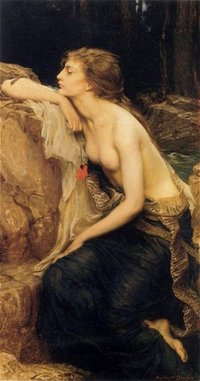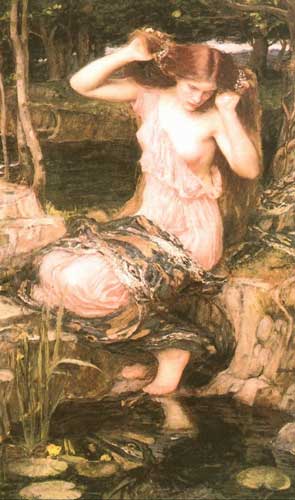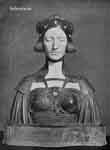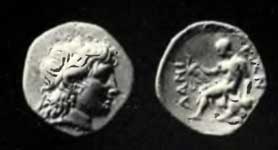
Lamia, 1909, by Herbert Draper (1864-1920)
Lamia is a mythological person: the daughter of Poseidon and Lybie. Lamia was a queen of Libya, whom Zeus loved. Hera turned her into a monster (or she killed Lamia's children and the grief turned her into a monster) and murdered their children. Lamia was cursed with the inability to close her eyes so that she would always obsess over the image of her dead children. Zeus gave her the gift to be able to take her eyes out to rest, and then put them back in. Lamia was envious of other mothers and ate their children. She had the body of a serpent and breasts and head of a woman. She was usually female, but occasionally male or hermaphroditic.
Lempriere (Lempriere's Dictionary) is of the opinion that Lamia is the model for Lamiae -- small African monsters whose hisses were pleasing but who destroyed children -- and that these are what are today called lemures.
In historical times mothers used to threaten their ill-born children with this story. John Keats wrote about the Lamia in Lamia and Other Poems, which was based on Anatomy of Melancholy. Also: blood-drinking female vampire-spirits were called Lamiae. A variety of Lamia are used in the role-playing game Dungeons and Dragons (artwork (http://www.wizards.com/dnd/images/MM35_gallery/MM35_PG164b.jpg) from Wizards of the Coast website). "The Lamia" is also a piece of music from the Genesis concept album, The Lamb Lies Down on Broadway. The black metal band Lord Belial has a song called "Lamia," from their album Enter the Moonlight Gate.

Lamia, 1909, by John William Waterhouse

------

Drachme , Lamia Head, Philoctetes on Lemnos, Text Lamiaion (Thessaly)
--------------------------------------------------------------------------------
Lamia in Bulgarian short stories and folk tales, is a mysterious creature with several heads, which can grow over and over again if cut, feeding on people's blood or (more often) killing young women. This monster often tortures villages and is to be found in caves or underground. In some tales, it has wings, in others, its breath is on fire. A Lamia has no gender but is usually perceived as a female.
--------------------------------------------------------------------------------
A Lamia in Basque legend is a water sprite that lives in caves. In Basque Country, there are many places named after these creatures. Sometimes they take the form of beautiful women and attract men. The only way to tell they are not women is to look at their feet which are the feet of a duck. In some other legends they are half human and half fish. Most of time, they are seen combing their hair with golden combs. The only way to anger them is to steal one of their combs. The rest of the time they are kind. Other Basque legends say they are just the goddess Mari.
Lamia (John Keats)

See also : Greek Mythology. Paintings, Drawings
Retrieved from "http://en.wikipedia.org/"
All text is available under the terms of the GNU Free Documentation License
| Ancient Greece
Science, Technology , Medicine , Warfare, , Biographies , Life , Cities/Places/Maps , Arts , Literature , Philosophy ,Olympics, Mythology , History , Images Medieval Greece / Byzantine Empire Science, Technology, Arts, , Warfare , Literature, Biographies, Icons, History Modern Greece Cities, Islands, Regions, Fauna/Flora ,Biographies , History , Warfare, Science/Technology, Literature, Music , Arts , Film/Actors , Sport , Fashion --- |

